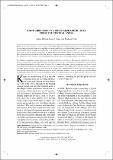Knot direction in a khipu/alphabetic text from the Central Andes
Abstract
Khipus are knotted-string devices that were used in the Inka Empire for communication and for recording information. We recently analyzed the names and associated khipu cords in a newly discovered hybrid khipu/alphabetic text from the Central Andes. Results indicate a significant relationship in the text between knot direction and a form of social organization known as moieties, in which S-knots correspond to the upper (Hanan) moiety and Z-knots correspond to the lower (Urin) moiety. This relationship suggests that knot direction was used to indicate moiety in Andean khipus and, as such, may represent the first decipherment of a structural element in khipus since the decoding of the number system in the 1920s.
Citation
Hyland , S P , Ware , G & Clark , M 2014 , ' Knot direction in a khipu/alphabetic text from the Central Andes ' , Latin American Antiquity: A Journal for the Society of American Archaeology , vol. 25 , no. 2 , pp. 189-197 . https://doi.org/10.7183/1045-6635.25.2.189
Publication
Latin American Antiquity: A Journal for the Society of American Archaeology
Status
Peer reviewed
ISSN
1045-6635Type
Journal article
Collections
Items in the St Andrews Research Repository are protected by copyright, with all rights reserved, unless otherwise indicated.

